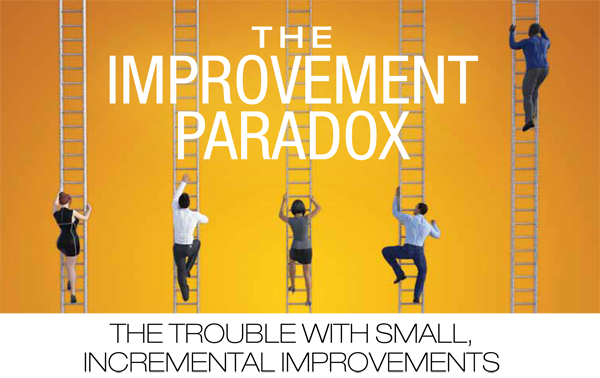The Improvement Paradox

by Howard Coleman
There are often times when incremental improvements, within a continuous improvement framework, are not enough. Incremental improvement can leave assumptions unchallenged. You might find yourself improving something that belongs in the history books. It can hold back your organization, perhaps even stifle significant development. Not everything that exists could have been developed by continuous improvement alone.
“The electric light did not come from the continuous improvement of candles,” wrote Oren Harari, a business professor at the University of San Francisco and author of several management books.
Some of us have recognized, earlier than others, that changes are coming that are necessary to our continued businesses success. It’s what I often describe as “doing the right things . . . and doing things right.” It often involves introducing new knowledge, new strategies and new approaches. It is triggered by external factors such as market conditions or new technology . . . or pandemics.
We are in one of those times now – one of radical change – and not only because COVID-19 has turbo-charged us, accelerated the need (kicked us in the rear?) to adopt different thinking as it relates to our business operations and technology adoption. Even before COVID-19, we were already on that journey, weren’t we? We have a need to do revolutionary things that have higher productivity and customer experience impact, developing and sharpening our change management skills that focus on every node in a company’s value stream, from labor, order fulfillment, optimal space needs, inside and outside sales processes, mining data, adjusting to the needs of e-commerce and more.
Some companies are better than others at correctly identifying these innovation and change needs but make the assumption that they need to start small. Yet the interim investment is meant to be part of something larger. The risk is the final product may end up as a false start. It’s often called “the improvement paradox.” Following this approach, the business case can get diluted from what could have been a more productive investment, causing a plateau at a lower level of performance.
So, our discussion here is not about innovation or process, it’s really about both. That being said, I realize there is danger in these holistic messages that are difficult to sell to fad-driven management audiences, as are those one-note-one-word-sambas such as “innovation,” “transformation” or “lean.” So, what happens? We fragment the discussion and return later (sometimes years later) to what we might have missed.
Kaizen
The Kaizen approach, a Japanese word that literally means improvement – continuous improvement, an improvement over the current condition – goes back to the 1950s. Many companies, like Toyota, which originated the concept, flourished using the methods synonymous with Kaizen. The knowledge and continuous improvement practices soon spread around the globe to all kinds of companies, and not just in capital intensive industries like auto manufacturing. Every conceivable type of company, distribution and service companies included, benefited.
Kaikaku
This brings us to Kaikaku, which means radical change/transformation. It describes the other side of improvement, the big leap. It implies a redesign of business processes that reach across the organization and the entire value stream. It fulfils the need for a more radical step change.
Let’s go back to our candle vs. light bulb analogy. While Kaizen improves upon the candle, Kaikaku is the installation of electric light.
So, let’s describe the paradox again because maybe it makes more sense now.
Both Kaizen and Kaikaku are essential strategies. Although you must understand the tenets of Kaizen as a series of short-term improvement success opportunities, the engagement of employees, and a bias towards practical improvement, they may not align with the longer-term direction of the business to deliver bottom-line results.
By focusing exclusively on these small improvements, an organization may miss an opportunity to gain competitive advantage in costs and customer experience. If competitors take a big leap, an organization will be left behind, still making candle-like efforts in a light bulb market.
Small improvements also commit resources that could be better spent toward a larger step forward in performance, or with more strategic planning, could have contributed to a major radical change.
The risk is a lack of re-imagining of what is possible through new technologies and new operational models.
Where a Kaikaku opportunity exists, the Kaizen path weakens the potential Kaikaku return-on-investment. It can end up costing more, extend the pay-back time and productivity can plateau at a lower level.
A Strategic Approach
For many companies, Kaikaku investments are made before Kaizen improvement. Strategic improvement plans are more robust when they consider costs that could have been avoided. These include the impact on buildings, land, equipment, labor, technology and the cost-of-service.
Even Kaikaku may be achievable in phases if it is planned that way from the start. Yes, it can be modular.
A more strategic approach like Kaikaku, optimizing ROI, avoiding plateauing and avoiding future costs, can protect an organization from being trapped in a focus on low-performance operations and being cursed with “The Improvement Paradox.”
Once organizations are aware of the potential for investments that create an improvement paradox, they are better able to consider potential improvements as part of a bigger, longer-term picture.
Kaizen may even make it more difficult to take the leap to transformation. The ROI is now extended, redesign is necessary and portions may need to be scrapped.
So, don’t get caught in the trap of half way. You don’t want to just catch up or keep pace with competitors; rather leap past them and take new ground.
Don’t allow radical change, or Kaikaku, to build real resistance to change.
As you lean forward on your journey, “Gambatte!” It means, do your best. If you have any questions along the way, we’re always happy to help.
 Howard W. Coleman is principal of MCA Associates, a management consulting firm that works with wholesale distribution and manufacturing companies seeking operational excellence. MCA implements continuous improvement solutions focused on business process re-engineering, inventory and supply chain management, sales development and revenue generation, information systems and technology, organizational assessment and development and family-business succession planning. Phone (203) 732-0603, or email hcoleman@mcaassociates.com.
Howard W. Coleman is principal of MCA Associates, a management consulting firm that works with wholesale distribution and manufacturing companies seeking operational excellence. MCA implements continuous improvement solutions focused on business process re-engineering, inventory and supply chain management, sales development and revenue generation, information systems and technology, organizational assessment and development and family-business succession planning. Phone (203) 732-0603, or email hcoleman@mcaassociates.com.
This article originally appeared in the Nov./Dec. 2020 issue of Industrial Supply magazine. Copyright 2020, Direct Business Media.













